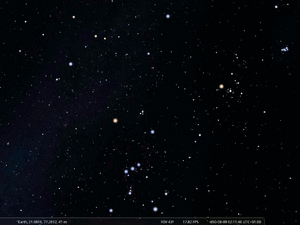Mrigashira: Difference between revisions
No edit summary |
No edit summary |
||
| Line 8: | Line 8: | ||
===Origin of Constellation=== |
===Origin of Constellation=== |
||
Mṛgaśira, Somya means "the deer's head"; it is a composite of two Sanskrit words, mṛga (मृग), deer, and śira (शिर), top of the head. The depiction in temples is here mapped to the three stars in Orion, but it may also be possible that The Deer as a constelllation had originally been larger and the three stars just formed a pattern on the top of its head (like they indicate the head of the Greek hero who is drawn in a larger star pattern). |
|||
| ⚫ | |||
| ⚫ | |||
===Transfer and Transformation of the Constellation=== |
===Transfer and Transformation of the Constellation=== |
||
Revision as of 07:03, 21 September 2025
Mṛgaśira (मृगशिर) is an Indian name, used by the Indian Vedic tradition. Most of these names are roughly 3000 years old. They pre-date Hinduism but were taken over by it. The asterism has three stars and, thus, refers to the group φ1,2 and λ Orionis.
Etymology and History
Origin of Constellation
Mṛgaśira, Somya means "the deer's head"; it is a composite of two Sanskrit words, mṛga (मृग), deer, and śira (शिर), top of the head. The depiction in temples is here mapped to the three stars in Orion, but it may also be possible that The Deer as a constelllation had originally been larger and the three stars just formed a pattern on the top of its head (like they indicate the head of the Greek hero who is drawn in a larger star pattern).
Also known as āgrahāyaṇī.
Transfer and Transformation of the Constellation
Mythology
mnemonic tales and cultural significance
Weblinks
References
- References (general)








